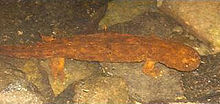The Cryptobranchoidea are a suborder of salamanders found in Asia, European Russia, and the United States. They are known as primitive salamanders, in contrast to Salamandroidea, the advanced salamanders.[1] It has two living subdivisions, Cryptobranchidae (Asian giant salamanders and hellbenders), and Hynobiidae, commonly known as Asian salamanders.
| Cryptobranchoidea | |
|---|---|

| |
| Cryptobranchus alleganiensis | |

| |
| Hynobius fossigenus | |
| Scientific classification | |
| Domain: | Eukaryota |
| Kingdom: | Animalia |
| Phylum: | Chordata |
| Class: | Amphibia |
| Order: | Urodela |
| Suborder: | Cryptobranchoidea Dunn, 1922 |
| Subgroups | |
| |
Giant salamanders are obligate paedomorphs with partial metamorphosis,[2] but Asiatic salamander goes through a full metamorphosis. The only known exceptions are the Longdong stream salamander, which has been documented as facultatively neotenic, and the Ezo salamander, where a now assumed extinct population from Lake Kuttarush in Hokkaido had neotenic traits like gills in adults.[3]
The oldest members of the group are known from the Middle Jurassic (Bathonian) aged Yanliao Biota of China.[4]
Taxonomy edit
This suborder contains only two families at present. All other members are extinct and are only known as fossils.
- †Chunerpeton Haifanggou Formation, China, Middle Jurassic (Bathonian) (neotenic, has alternatively been recovered outside of Cryptobranchoidea)[5]
- †Jeholotriton Haifanggou Formation, China, Middle Jurassic (Bathonian) (neotenic)
- †Pangerpeton Haifanggou Formation, China, Middle Jurassic (Bathonian)
- †Nesovtriton Bissekty Formation, Uzbekistan, Late Cretaceous (Turonian)
- †Iridotriton Morrison Formation, United States, Late Jurassic (Tithonian)
- †Kiyatriton Itat Formation, Russia, Middle Jurassic (Bathonian) Ilek Formation, Russia, Early Cretaceous (Barremian-Aptian) (Presumed to be a cryptobranchoid)
- †Laccotriton Fengshan fossil bed, China, Late Jurassic (Tithonian)
- †Sinerpeton Fengshan fossil bed, China, Late Jurassic (Tithonian)
- Cryptobranchidae (Late Cretaceous-Recent)
- Panhynobia[4]
- †Liaoxitriton Jiufotang Formation, China, Early Cretaceous (Aptian)
- †Linglongtriton Tiaojishan Formation, China, Late Jurassic (Oxfordian)
- †Neimengtriton Haifanggou Formation, China, Middle Jurassic (Bathonian)
- †Regalerpeton Dabeigou Formation, China, Early Cretaceous (Hauterivian)
- †Nuominerpeton Longjiang Formation, China, Early Cretaceous (Aptian)
- Hynobiidae (Miocene-Recent)
References edit
- ^ Heying, Heather. "ADW:Family Cryptobranchidae: giant salamanders and hellbenders".
- ^ Evidence for complex life cycle constraints on salamander body form diversification
- ^ Osteology of Batrachuperus londongensis (Urodela, Hynobiidae): study of bony anatomy of a facultatively neotenic salamander from Mount Emei, Sichuan Province, China
- ^ a b Jia, Jia; Anderson, Jason S.; Gao, Ke-Qin (2021-07-23). "Middle Jurassic stem hynobiids from China shed light on the evolution of basal salamanders". iScience. 24 (7): 102744. doi:10.1016/j.isci.2021.102744. ISSN 2589-0042. PMC 8264161. PMID 34278256.
- ^ Rong, Yu-Fen; Vasilyan, Davit; Dong, Li-Ping; Wang, Yuan (2020-12-08). "Revision of Chunerpeton tianyiense (Lissamphibia, Caudata): Is it a cryptobranchid salamander?". Palaeoworld. 30 (4): 708–723. doi:10.1016/j.palwor.2020.12.001. ISSN 1871-174X.